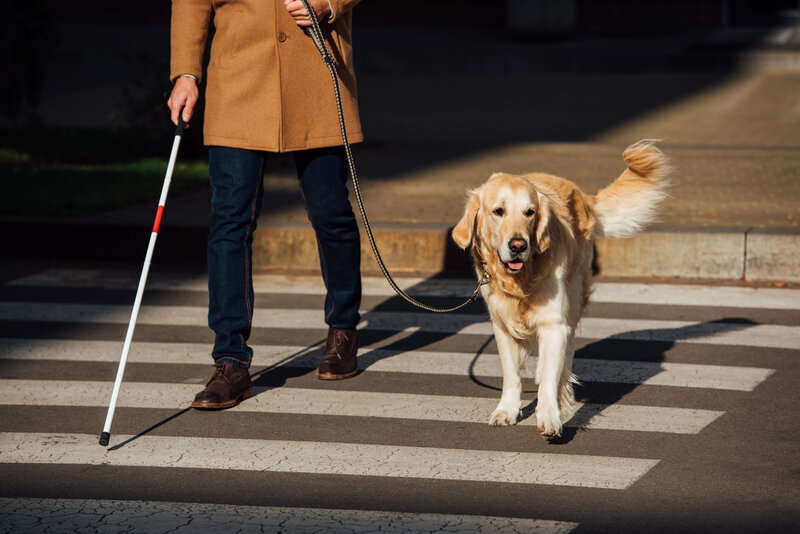What Is Legal Blindness?

Vision loss is measured in degrees, ranging from normal to profound. Legal blindness falls in the severe category. The Social Security Act defines individuals as legally blind when their visual acuity (sharpness of vision) is 20/200 or lower. This means that even with corrective lenses, they have to be 20 feet away to distinguish something that a normally-sighted person can see at 200 feet.
To give you a better idea of where this category fits into the whole, the following is taken from the World Health Organization’s vision classifications:
- Normal: 20/10-20/25
- Near normal visual impairment: 20/30-20/60
- Moderate visual impairment: 20/70-20/160
- Severe visual impairment: 20/200-20/400 or 11-20 degrees on visual field
- Profound visual impairment: 20/500-20/1000 visual acuity or 6- 10 degrees on visual field
- Near total visual impairment: Counting fingers, hand motion, light perception, or 5 degrees or less on visual field
- Total visual impairment: No light perception
These WHO and SSA definitions of legal blindness are critical because a person who is legally blind qualifies for government-funded support and resources they don’t have access to otherwise. Those benefits can make all the difference in a higher-quality, socially engaged, daily life.
Determining visual acuity, or establishing legal blindness, takes more than a simple test using the Snellen Eye Chart. Optometrists use a range of tools to determine vision loss and its cause, working closely with patients to find customized solutions.
Legal Blindness: What Can You See & What Can You Do?
Contrary to what you might think, legally blind individuals can see well enough to do all kinds of things, like:
- Read.
- Play music.
- Prepare meals.
- Manage finances.
- Create art and participate in all kinds of creative hobbies.
- Take public transportation anywhere they want to go.
- Pursue any level of education.
- Maintain a successful career.
- Have a normal social life.
- Live independently.
- Travel the world.
- And more!
However, they require a combination of resources to optimize independence. While eyeglasses or contacts may help to improve vision to a point, they’re not enough support to correct vision above the very poor to severe categories. Similarly, legal blindness cannot be corrected by surgical procedures like LASIK or cataract surgery.
What Would I See (Or Not See) If I Was Legally Blind?
Some of the most common causes of severe vision loss are:
- Cataracts (51%)
- Glaucoma (8%)
- Age-related macular degeneration (5%)
- Corneal opacification (4%)
- Childhood or genetic blindness (4%)
- Refractive errors (3%)
- Trachoma (3%)
- Diabetic retinopathy (1%)
- Undetermined (21%)
Legal blindness happens in different ways for different people. For some, it is a very general blurriness that affects the entire field of vision. For others, their vision may be most limited in the central or peripheral fields.
People who are legally blind may also experience wavy or distorted vision, difficulty seeing colors (unrelated to being color blind), and struggle to see at night or in poorly lit locations.
Resources For Those With Severe Vision Loss
Regardless, people who are legally blind have a range of resources at their disposal, and the sooner you take advantage of them, the more adept you’ll become (some require a learning curve).
Manage underlying health conditions
If vision loss is connected to a health condition, healthcare management is a critical step in preventing further or expedited vision loss. Eat well, take prescriptions as required, maintain routine checkups with physicians and specialists, etc.
Learn about magnification tools and apps for legal blindness
Tech gadgets greatly help people with severe vision loss because you can increase fonts and change their colors to support reading. Speak to your optometrist about other magnification tools that can support daily reading depending on your environment.
Optimize task lighting (and safety) everywhere
Poorly lit areas make it even more challenging to see, whether you’re normally sighted or not. If you have any level of visual impairment, customize interior and task lighting to support vision and safety. More light isn’t necessarily better if it’s not the right quality of the resulting glare hinders more than helps.
Read Architectural Digest’s post on How to Modify a Home for Low Vision for detailed tips and recommendations. Some of the most important include:
- Eliminating trip hazards.
- Choosing fixtures that optimize lighting while minimizing glare.
- Increase natural daylighting as much as you can.
- Create color contrasts that support daily workflow.
- Organize the home in a way that supports increased accessibility at eye level.
Optimizing task and safety lighting in homes and workplaces is essential to support vision.
Connect with local resources for the blind
There are many resources for those who fall into the legally blind category. The following are some of our favorites:
- American Foundation for the Blind
- VisionAware resources and information
- A comprehensive PDF list of Oklahoma Blind/Visual Impairment Resources
- Oklahoma Department of Visual Services
- Sapulpa Community Care
- Oklahoma School for the Blind
And, of course, your optometrist and ophthalmologist can be your greatest allies.
Eye to Eye Family Vision Care Is Here To Support Our Legally Blind Community
Whether you’ve just received a diagnosis of a progressive eye condition or you’re in the early stages of low to severe vision loss, the team at Eye to Eye Family Vision Care is here to help. We are a primary resource for ensuring patients have everything they need to lead high-quality and enjoyable lives no matter what their future vision holds. Contact us to learn more about how we can support you and your family.

